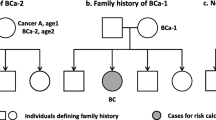Abstract
Triple-negative breast cancer accounts for less than 20% of breast cancers overall, but is the predominant subtype among carriers of mutations in BRCA1. However, few studies have assessed the association between breast cancer family history and risk of triple-negative breast cancer. We examined the relationship between having a family history of breast cancer in first-degree relatives and risk of triple-negative breast cancer, and risk of two other breast cancer subtypes defined by tumor marker expression. We evaluated data collected by the Breast Cancer Surveillance Consortium from 2,599,946 mammograms on 1,054,466 women, among whom 15% reported a first-degree family history of breast cancer. Using Cox regression in this cohort, we evaluated subtype-specific associations between family history and risk of triple-negative (N = 705), estrogen receptor-positive (ER+, N = 10,026), and hormone receptor-negative/HER2-expressing (ER−/PR−/HER2+, N = 308) breast cancer among women aged 40–84 years. First-degree family history was similarly and significantly associated with an increased risk of all the subtypes [hazard ratio (HR) = 1.73, 95% confidence interval (CI): 1.43–2.09, HR = 1.62, 95% CI: 1.54–1.70, and HR = 1.56, 95% CI: 1.15–2.13, for triple-negative, ER+, and ER−/PR−/HER2+, respectively]. Risk of all the subtypes was most pronounced among women with at least two affected first-degree relatives (versus women with no affected first-degree relatives, HRtriple-negative = 2.66, 95% CI: 1.66–4.27, HRER+ = 2.05, 95% CI: 1.79–2.36, HRER−/PR−/HER2+ = 2.25, 95% CI: 0.99–5.08). Having a first-degree family history of breast cancer was associated with an increased risk of triple-negative breast cancer with a magnitude of association similar to that for the predominant ER+ subtype and ER−/PR−/HER2+ breast cancer.
Similar content being viewed by others
Abbreviations
- ER:
-
estrogen receptor
- PR:
-
progesterone receptor
- HR:
-
hazard ratio
- CI:
-
confidence interval
- BCSC:
-
Breast Cancer Surveillance Consortium
- IHC:
-
immunohistochemistry
- FISH:
-
fluorescence in situ hybridization
References
Perou CM, Sorlie T, Eisen MB, van de Rijn M, Jeffrey SS, Rees CA, Pollack JR, Ross DT, Johnsen H, Akslen LA, Fluge O, Pergamenschikov A, Williams C, Zhu SX, Lonning PE, Borresen-Dale AL, Brown PO, Botstein D (2000) Molecular portraits of human breast tumours. Nature 406:747–752
Carey LA, Perou CM, Livasy CA, Dressler LG, Cowan D, Conway K, Karaca G, Troester MA, Tse CK, Edmiston S, Deming SL, Geradts J, Cheang MC, Nielsen TO, Moorman PG, Earp HS, Millikan RC (2006) Race, breast cancer subtypes, and survival in the Carolina Breast Cancer Study. JAMA 295:2492–2502
Onitilo AA, Engel JM, Greenlee RT, Mukesh BN (2009) Breast cancer subtypes based on ER/PR and Her2 expression: comparison of clinicopathologic features and survival. Clin Med Res 7:4–13. doi:7/1-2/4[pii]10.3121/cmr.2009.825
Kim MJ, Ro JY, Ahn SH, Kim HH, Kim SB, Gong G (2006) Clinicopathologic significance of the basal-like subtype of breast cancer: a comparison with hormone receptor and Her2/neu-overexpressing phenotypes. Hum Pathol 37:1217–1226
Del Casar JM, Martin A, Garcia C, Corte MD, Alvarez A, Junquera S, Gonzalez LO, Bongera M, Garcia-Muniz JL, Allende MT, Vizoso F (2008) Characterization of breast cancer subtypes by quantitative assessment of biological parameters: relationship with clinicopathological characteristics, biological features and prognosis. Eur J Obstet Gynecol Reprod Biol 141(2):147–152
Foulkes WD, Stefansson IM, Chappuis PO, Begin LR, Goffin JR, Wong N, Trudel M, Akslen LA (2003) Germline BRCA1 mutations and a basal epithelial phenotype in breast cancer. J Natl Cancer Inst 95:1482–1485
Haffty BG, Yang Q, Reiss M, Kearney T, Higgins SA, Weidhaas J, Harris L, Hait W, Toppmeyer D (2006) Locoregional relapse and distant metastasis in conservatively managed triple negative early-stage breast cancer. J Clin Oncol 24:5652–5657
Parise CA, Bauer KR, Brown MM, Caggiano V (2009) Breast cancer subtypes as defined by the estrogen receptor (ER), progesterone receptor (PR), and the human epidermal growth factor receptor 2 (HER2) among women with invasive breast cancer in California, 1999–2004. Breast J 15:593–602. doi:TBJ822[pii]10.1111/j.1524-4741.2009.00822.x
Bauer KR, Brown M, Cress RD, Parise CA, Caggiano V (2007) Descriptive analysis of estrogen receptor (ER)-negative, progesterone receptor (PR)-negative, and HER2-negative invasive breast cancer, the so-called triple-negative phenotype: a population-based study from the California cancer Registry. Cancer 109:1721–1728
Yang XR, Sherman ME, Rimm DL, Lissowska J, Brinton LA, Peplonska B, Hewitt SM, Anderson WF, Szeszenia-Dabrowska N, Bardin-Mikolajczak A, Zatonski W, Cartun R, Mandich D, Rymkiewicz G, Ligaj M, Lukaszek S, Kordek R, Garcia-Closas M (2007) Differences in risk factors for breast cancer molecular subtypes in a population-based study. Cancer Epidemiol Biomarkers Prev 16:439–443
Millikan RC, Newman B, Tse CK, Moorman PG, Conway K, Smith LV, Labbok MH, Geradts J, Bensen JT, Jackson S, Nyante S, Livasy C, Carey L, Earp HS, Perou CM (2008) Epidemiology of basal-like breast cancer. Breast Cancer Res Treat 109:123–139
Ballard-Barbash R, Taplin SH, Yankaskas BC, Ernster VL, Rosenberg RD, Carney PA, Barlow WE, Geller BM, Kerlikowske K, Edwards BK, Lynch CF, Urban N, Chrvala CA, Key CR, Poplack SP, Worden JK, Kessler LG (1997) Breast Cancer Surveillance Consortium: a national mammography screening and outcomes database. AJR Am J Roentgenol 169:1001–1008
Collaborative Group on Hormonal Factors in Breast Cancer (2001) Familial breast cancer: collaborative reanalysis of individual data from 52 epidemiological studies including 58,209 women with breast cancer and 101,986 women without the disease. Lancet 358:1389–1399
Pharoah PD, Day NE, Duffy S, Easton DF, Ponder BA (1997) Family history and the risk of breast cancer: a systematic review and meta-analysis. Int J Cancer 71:800–809
Kalbfleisch JD, Prentice RL (2002) The statistical analysis of failure time data. Wiley, New York
Raghunathan TE, Lepkowski JM, Van Hoewyk J, Solenberger P (2001) A multivariate technique for multiply imputing missing values using a sequence of regression models. Surv Methodol 27:85–95
Negri E, Braga C, La Vecchia C, Franceschi S, Parazzini F (1997) Family history of cancer and risk of breast cancer. Int J Cancer 72:735–738
Anderson H, Bladstrom A, Olsson H, Moller TR (2000) Familial breast and ovarian cancer: a Swedish population-based register study. Am J Epidemiol 152:1154–1163
Li CI, Daling JR, Malone KE, Bernstein L, Marchbanks PA, Liff JM, Strom BL, Simon MS, Press MF, McDonald JA, Ursin G, Burkman RT, Deapen D, Spirtas R (2006) Relationship between established breast cancer risk factors and risk of seven different histologic types of invasive breast cancer. Cancer Epidemiol Biomarkers Prev 15:946–954. doi:15/5/946[pii]10.1158/1055-9965.EPI-05-0881
Carpenter CL, Ross RK, Paganini-Hill A, Bernstein L (2003) Effect of family history, obesity and exercise on breast cancer risk among postmenopausal women. Int J Cancer 106:96–102. doi:10.1002/ijc.11186
Lund MJ, Trivers KF, Porter PL, Coates RJ, Leyland-Jones B, Brawley OW, Flagg EW, O’Regan RM, Gabram SG, Eley JW (2009) Race and triple negative threats to breast cancer survival: a population-based study in Atlanta, GA. Breast Cancer Res Treat 113:357–370. doi:10.1007/s10549-008-9926-3
Ford D, Easton DF, Peto J (1995) Estimates of the gene frequency of BRCA1 and its contribution to breast and ovarian cancer incidence. Am J Hum Genet 57:1457–1462
Potter JD, Cerhan JR, Sellers TA, McGovern PG, Drinkard C, Kushi LR, Folsom AR (1995) Progesterone and estrogen receptors and mammary neoplasia in the Iowa Women’s Health Study: how many kinds of breast cancer are there? Cancer Epidemiol Biomarkers Prev 4:319–326
Cotterchio M, Kreiger N, Theis B, Sloan M, Bahl S (2003) Hormonal factors and the risk of breast cancer according to estrogen- and progesterone-receptor subgroup. Cancer Epidemiol Biomarkers Prev 12:1053–1060
Althuis MD, Fergenbaum JH, Garcia-Closas M, Brinton LA, Madigan MP, Sherman ME (2004) Etiology of hormone receptor-defined breast cancer: a systematic review of the literature. Cancer Epidemiol Biomarkers Prev 13:1558–1568
Welsh ML, Buist DS, Aiello Bowles EJ, Anderson ML, Elmore JG, Li CI (2008) Population-based estimates of the relation between breast cancer risk, tumor subtype, and family history. Breast Cancer Res Treat 114(3):549–558
Bradbury AR, Olopade OI (2007) Genetic susceptibility to breast cancer. Rev Endocr Metab Disord 8:255–267
Acknowledgments
We thank the participating women, mammography facilities, and radiologists for the data they have provided for this study. A list of the BCSC investigators and procedures for requesting BCSC data for research purposes are provided at: http://breastscreening.cancer.gov/.
Conflict of interest
The authors declare that they have no competing interests.
Financial support
This study was supported by a National Cancer Institute-funded Breast Cancer Surveillance Consortium co-operative agreement (U01CA63740, U01CA86076, U01CA86082, U01CA63736, U01CA70013, U01CA69976, U01CA63731, and U01CA70040). The collection of cancer data used in this study was supported in part by several state public health departments and cancer registries throughout the U.S. For a full description of these sources, please see: http://breastscreening.cancer.gov/work/acknowledgement.html. This publication was supported by grant number T32 CA09168 and R25-CA94880 from the National Cancer Institute, National Institutes of Health. The contents of this publication are solely the responsibility of the authors and do not necessarily represent the official views of the National Cancer Institute or the National Institutes of Health.
Author information
Authors and Affiliations
Corresponding author
Rights and permissions
About this article
Cite this article
Phipps, A.I., Buist, D.S.M., Malone, K.E. et al. Family history of breast cancer in first-degree relatives and triple-negative breast cancer risk. Breast Cancer Res Treat 126, 671–678 (2011). https://doi.org/10.1007/s10549-010-1148-9
Received:
Accepted:
Published:
Issue Date:
DOI: https://doi.org/10.1007/s10549-010-1148-9




